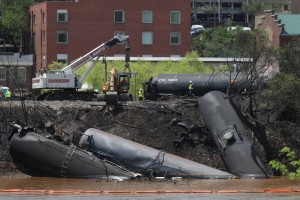By Richard Shapiro, Virginia Railroad Accident Attorney
A section of railroad track that was owned by CSX in Lynchburg, Virginia (VA) was set to be replaced – the day after a crude oil trail derailed and broke out in flames.
The National Transportation Safety Board issued this report in late August into the derailment, which occurred on April 30, 2014. The Lynchburg oil train derailment required the evacuation of hundreds of people from downtown.
The NTSB still has not determined the precise cause of the wreck, but should by the end of 2015.
NTSB documents state that the derailment happened at a break point in the track, which means that the rail section was cracked or severed. The break was only a few inches from a repair that was made in January 2014.
The day before the oil train derailed, an inspection of the track section showed there was an internal flaw in that same rail piece. So, CSX planned to replace a 40 foot section of the rail, which was going to be installed on May 1, 2014.
The derailment is one of about nine oil train derailments that have happened in North America since 2013. The biggest and most tragic was the derailment in Lac Megantic, Quebec in July 2013 that killed 47 people.
In Lynchburg, 17 oil tank cars derailed, with three plunging into the James River and one caught on fire.
Our Virginia railroad accident law office has extensive experience in train accidents and derailments, as well as railroad crossing accidents that were due to train engineer or railroad company negligence. These often preventable mishaps can lead to injury and loss of life, although we are glad the Lynchburg incident resulted in no injuries.
We have represented workers who have been injured by railroad company negligence in the past, such as a CSX conductor who was exposed to asbestos fibers in his work for decades. That case resulted in an $8.6 million verdict.
We hope that CSX and other companies in the industry will put a better focus on safety – both for the safety of the public and the environment.
